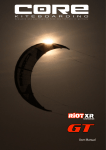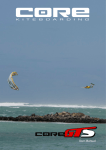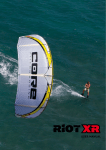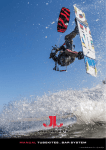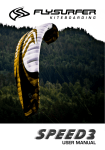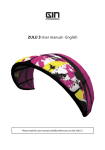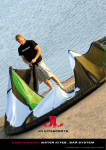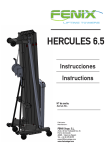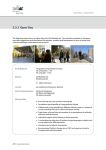Download User Manual
Transcript
User Manual v1.2 User Manual 1 User Manual v1.2 Warning: Kiteboarding is dangerous We advise to take professional instruction if you want to learn kitesurfing Always use extreme caution when using this equipment Only use this product if you are in good physical and mental shape For Safety reasons Corekites should only be used on the water When using this product your are responsible for your own and others safety Always use the 5th line safety in order to not endanger others Always use the right kite size for your ability and wind conditions. Be aware that strong gusts can potentially be life threatening. Any advice regarding the windrange of the kite is based on the use by experts and should only be used as a rough guide. • Never kite when there are obstacles downwind of you. • Never kite in off- or onshore wind conditions. • • • • • • • Release Of Liability, Claim Waiver, Assumption of Risk By assembling and/or using this Core Kite Product, you agree that you have read and understood the entire Core Kiteboarding Product Owner’s Manual, including all instructions and warnings contained in that Manual, prior to using the Core Kiteboarding Product in any way. You additionally agree that you will ensure any additional or subsequent user of your Core Kiteboarding Product will read and understand the entire Core Kiteboarding Product Owner’s Manual, including all instructions and warnings contained in that Manual, prior to allowing that person to use your Core Kiteboarding Product. ASSUMPTION OF RISK Use of the Core Kiteboarding Product and any of its components involve certain inherent risks, dangers, and hazards that can result in serious personal injury and death to both the user and to nonuser third parties. In using the Core Kiteboarding Product, you freely agree to assume and accept any and all known and unknown risks of injury to you and to third parties while using this equipment. The risks inherent in this sport can be greatly reduced by abiding by the warning guidelines listed in this owner manual and by using common sense. RELEASE AND WAIVER OF CLAIMS In consideration of the sale of the Core Kiteboarding product to you, you hereby agree to the fullest extent permitted by law, as follows: TO WAIVE ANY AND ALL CLAIMS that you have or may in the future have against Hiss-Tec Fehmarn and all related parties resulting from use of the Core Kiteboarding Product and any of its components. TO RELEASE Hiss-Tec Fehmarn and all related parties from any and all liability for any loss, damage, injury or expense that you or any users of your Core Kiteboarding Product may suffer, or that your next of kin may suffer, as a result of the use of the Core Kiteboarding Product, due to any cause whatsoever, including negligence or breach of contract on the part of Hiss-Tec Fehmarn and all related parties in the design or manufacture of the Core Kiteboarding Product and any of its components. In the event of your death or incapacity, all provisions contained herein shall be effective and binding upon your heirs, next of kin, executors, administrators, assigns, and representatives. Hiss-Tec Fehmarn-related parties have not made and expressly deny any oral or written representations other than what is set forth herein and the Core Kite Product User’s Manual. 2 User Manual v1.2 CORE & ESP BAR SYSTEM Short manual: CORE GT and CORE ESP CONTROL SYSTEM Setup Bar and flying lines The new Core ESP Control System is ready for plug & play. Just unwind your lines, attach them to the kite and have fun! The following instructions and the picture on the left should give you a quick overview how to setup your new kite and bar. K PREFLIGHT CHECKLIST D C C A A B1 D 1. Make sure your launch is open, FREE OF DOWNWIND BYSTANDERS, hard objects, nearby power lines, buildings and walls, within at least 200 ft. (60 m), and preferably more. Some riders have needed in excess of 500 ft. (170 m), to regain control in violent dragging or loftings. Avoid kiteboarding near airports and in low flight path areas, complaints have led to restricted access in some areas. 2. Check to see what size kite other kiteboarders are rigging and get their input on conditions. Do not rig too large a kite for conditions and carefully consider advice of more experienced riders. Failure to act on prudent advice has cost some riders severe injury. 3. Check your kite for tears or leaky bladders. If you have leaky bladders or tears in your kite, repair them before flying. 4. Check ALL kite, harness, control bar lines, webbing, pigtails, bridles, the chicken loop and leaders for knots, wear or abrasions. If the line sheathing shows any breaks, replace them. The pigtails should be replaced no less frequently than every 6 months on inflatable kites. Inspect and test your EJECTOR quick release. 5. Make sure your flying lines are equal as they will stretch unevenly with use. If they have knots that can´t be easily untied, replace your flight lines. 6. Walk down your lines and examine them carefully. Just before launch pick your bar up and carefully look down the lines for twists and tangles that could cause the kite to be dangerously uncontrollable. While you are holding your bar up look down the lines, shake your bar to make sure the center lines are connected to the leading edge of the kite. Be particularly careful, slow and methodical in high winds. Multiple, careful preflighting in higher winds is strongly advised. Inflate the kite to a max of 6psi and close the FastPump-Clamps properly. To depower the kite with the adjuster , always keep a little tension on the backlines. B2 With the minihook the rider can fix the bar in the powered position. This is usefull in jumps and in low wind cruising. Beginners should allways take off the minihook rope to prevent hooking in when starting the kite. G Before starting the kite you should allways check all bar safety systems and feel comfortable with all features on the bar. Double-check the weather conditions and if you´re in doubt, don´t go out! A: Powerlines (black), red attachment point for left side, grey attachment point for right side B1: Left steering line - red B2: Right steering line - white C: Attachment points for power lines D: Attachment points for steering lines E: Pull-Pull Adjuster F: Adjustable steering lines (inside floater) G: 5th line with stopperball (red) H: Variable bar widths I: EJECTOR safety release system J: Safetyleash with safety leash release K: Exchangable pulley lines E F F H I H J 3 User Manual v1.2 Rigging the Kite Step 1 Check the wind conditions in order to choose the correct kite size. Lay out the kite. The arrow in the sand indicates the wind-direction. Secure the upwind wingtip with sand and make sure that all FASTPUMP cleats are open to allow proper inflation of the kite. Check that all bridle lines are evenly laid out and free off tangles. Step 2 Go to the centre of the kite leading edge and take a look at the inlet and outlet valves. Both valves have different air lock systems. The larger valve is for the deflation of the kite and the smaller one for the kites inflation. Step 3 Close the outlet (larger) valve thoroughly and secure it with the velcro and the rubber band as shown in the picture. This double safety closure prevents any unsuspected opening of the valve e.g. when the kite is crashed hard onto the water. Step 4 There is a Pump-leash on the pump that secures the kite and stops it from blowing away during the inflation process. Make sure to connect the Pump-leash thoroughly onto the specifically designed loop on the kites leading edge (the same loop to which the 5th line is connected). 4 User Manual v1.2 Rigging the kite Step 5 Push the pump nozzle into the inlet (smaller) valve and start to inflate the kite. Step 6 Inflate until the kite is almost full and then turn around until your back is facing towards the wind. Step 7 Now fully inflate the kite up to 6-7PSI. Check that all struts are inflated properly. The maximum inflation pressure for the kite is 7PSI. If the kite is under inflated it has poor performance and the relaunch can be difficult. Over inflated kites can burst, especially when they sit in the sun for any length of time. Step 8 Flip the kite over, position it on its leading edge and weigh down with lots of sand. A pre-filled linen sandbag is ideal for none sandy beaches. Now you can unwind the lines from the bar and attach them to the kite as shown in the graphic on page 3. 5 User Manual v1.2 THE EJECTOR SYSTEM 1 Push the yellow Ejector upwards and away from you to open the system. 4 To re-assemble the system hold the Chickenloop in one hand and push up the yellow Ejector with the other hand. 7 Be careful that there is no sand or dirt in the system. 3 2 This releases the Safety-pin. 5 The Chickenloop opens. The rider is now only connected to the kite via the 5th Line. 6 Push the metal loop over the Safetypin. 8 Now guide the metal loop and the Safety-pin back into their designated grooves. 10 When the Chickenloop and Safety-pin are in the correct position, 6 let the yellow Ejector slide back into its original position. User Manual v1.2 Activating the EJECTOR SECURITY SYSTEM 1 In an emergency grab the Ejector with one or both hands and push upwards away from you. 2 3 The bar slides along the 5th line up to the Stopperball. 4 The kite descends without pull at the edge of the wind window. 5 The kite lands on the water. Kite goes into the face to face position automatically. 6 7 Face to face position is 100% pull free. It might happen that on steering line lays over the tip. 8 9 To get the kite into relaunch position, you have to pull in one steering line for 2m. You have to pull in the steering line that is not lying over the tip. Keep tension on the line until the kite is back in relaunch position. 7 User Manual v1.2 Relaunch: Face to face To start the kite again from the face to face position you have to pull in one steering line for around 2m. Keep tensioning the steering-line to enable the kite to right itself up further. Keep tensioning the steering-line. When the tip catches wind again the kite will get into relaunch position. Let the pulled in steering line go, depower the kite and pull on one floater to direct the kite out of the powerzone. 8 User Manual v1.2 Relaunch Relaunch is very easy. Depower the kite and pull on one floater. The kite will immediatly travel to one side. Keep tensioning the steering-line. When the kite reaches the border of the powerzone let the floater go and wait until the kite is fully in restart position. Steer the kite up and sheet the bar out to restart the kite. The kite is airborne again. 9 User Manual v1.2 Trim Via Adjuster / Function Of The Adjuster The CORE Bar has a pull-pull adjuster, that means depowering and powering of the kites is done with the two pull straps. pulling the right slope. The yellow strap is for depowering the kite: pull it towards you to shorten the front lines and depower the kite. The green strap is the powerstrap to power the kite and opening the adjuster. When pulling the powerstrap the adjuster opens stepwise and you‘re able to power the kite again. The advantage of this system is very clear: You‘re able to trim the kite very exact and with control. basic settings This is the home position of the adjuster. Both straps are hanging down, easily obtainable above the depower line. The yellow strap with the CORE label is the depowerstrap. The green strap is the powerstrap to open the adjuster. You need to pull both straps to use the adjuster correctly. pulled adjuster / kite is depowered By pulling the yellow depowerstrap the adjuster gets shorter and the front lines are shortened - this depowers the kite. This is a safety function when starting the kite or to trimm the kite when the wind is increasing. open the adjuster / power the kite To open the the adjuster or powering the kite you need to pull the green powerstrap. The strap opens stepwise - to open the adjuster completely you need to pull multiple times. That‘s how you can reach an ideal trim of your kite. The Minihook With the minihook the rider can fix the bar in the powered position. This is usefull in jumps and in low wind cruising. Beginners should allways take off the minihook rope to prevent hooking in when starting the kite. Before starting the kite you should allways check all bar safety systems and feel comfortable with all features on the bar. 10 User Manual v1.2 Chickenstick The picture shows the assembly of the Chickenstick. It has to be on the right side of the chickloop (riders point of view) and then attached to the harness hook. Maintenance Of The Bridle Lines The bridle lines must be controlled and maintained before every usage of the kite. After using the kite, the lines should be washed with fresh-water and checked for wear and tear. Sand must be removed completely. We recommend to attach the front bridle attachment point to the back bridle attachment to avoid accidently twisting and knotting of the bridle while packing the kite. Always check the pulleys for free movement! Bridle Line Trim (experienced users only) The GT has some bridle tuning points for the front bridle. Using the point pointing to the middle of the kite will increase kite feedback, using the point more to the tip will decrease bar pressure. The standard setup is the point in the middle. These trim/set-up options are designed for the experienced user. The bridling has to be partly taken apart and it is of utmost importance that the lines are re-connected and in the right place. Modifications on bridle settings happen on your own danger. Hiss-Tec Fehmarn assumes no liability! P1 P2 P4 P3 A1 P5 B2 sp C1 pr B1 pf 11 User Manual v1.2 Hiss-Tec Fehmarn WARRANTY POLICY Hiss-Tec Fehmarn warrants this product to be free of major defects in material or workmanship to the original purchaser for a period of six months from the date of purchase. This warranty is subject to the following limitations: The warranty is valid only when the product is used for kiteboarding on water and does not cover products used in rental or teaching operations. Hiss-Tec Fehmarn will make the final warranty determination, which may require inspection and/or photos of the equipment, which clearly show the defect(s). If necessary, this information must be sent to the Core Kiteboarding distributor in your country, postage prepaid. If a product is deemed to be defective by Hiss-Tec Fehmarn, the warranty covers the repair or replacement of the defective product only. Hiss-Tec Fehmarn will not be responsible for any costs, losses or damages incurred as a result of loss of use of this product. The warranty does not cover damage caused by misuse, abuse, neglect or normal wear and tear including but not limited to, rigging with other than Hiss-Tec Fehmarn components, damage due to excessive sun exposure, damage caused by improper handling or storage, damage caused by use in the waves or shore break and damage caused by anything other than defects in material and workmanship. This warranty is voided if any unauthorized repair, change or modification has been made to any part of the equipment. The warranty for any repaired or replaced equipment is good from the date of the original purchase only. The original purchase receipt must accompany all warranty claims. The name of the retailer and date of purchase must be clear and legible. There are no warranties that extend beyond the warranty specified herein. Warranty Claims Warranty claims must be processed and be issued a return authorization prior to shipping to Hiss-Tec Fehmarn. PLEASE CALL OR WRITE FOR CLAIMS PROCESSING TO THE NATIONAL CORE KITEBOARDING DISTRIBUTOR. Contact, Service and Advice Get all CORE products and further advice at your national distributor, on www.corekites.com/en or directly at CORE Kiteboarding in Germany: Hiss-Tec Fehmarn Am Steinkamp 28 23769 Burg auf Fehmarn GERMANY T: +49 4371 3950 F: +49 4371 879334 [email protected] 12












